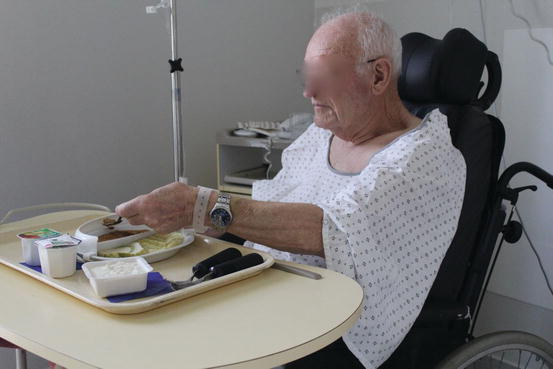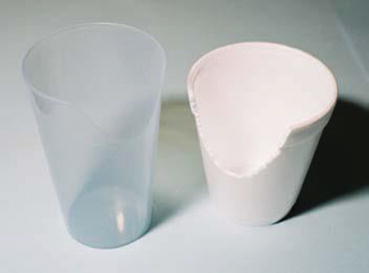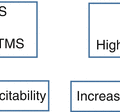Fig. 38.1
Technical aids and modified meal texture. Note that vegetables, meat, and starch are separated for better tasting
Postural adaptations first concern global posture (Figs. 38.2 and 38.3). The subject should not be lying down to eat. In a sitting or semi-sitting position, the trunk is properly supported. After the meal it is recommended to stay in this position and not to immediately lie down in order to reduce the risk of acid regurgitation. Neck posture directly impacts swallowing. Lateral bending or hyperextension of the neck which leads mechanically to opening of the larynx should be avoided because they decrease the efficiency of pharyngeal propulsion. The patient should be encouraged to flex the neck as this avoids aspiration on its own in 55% of dysphagic subjects [17]. Furthermore, this position allows the epiglottis to move posteriorly, thus enlarging the vallecular space. In the event of hemilarynx, palsy rotation on the side of the palsy allows better glottal closing and airway protection. Additionally this posture leads to better relaxation of the upper esophageal sphincter and reduces the possibility of stasis in the pharynx and piriform recess.



Fig. 38.2
A patient with right-side hemiplegia and right-side laryngeal paralysis in the adequate position for assisted feeding

Fig. 38.3
Use of technical aids for easier and safe self-feeding
Environmental adaptations can also be made during the meals of dysphagic subjects. The direct environment should be quiet with few distractors such as TV and radio. The subject is also instructed to focus all his attention on swallowing and to avoid speaking during the meal. The risk of aspiration during the inspiratory whoop is real. Instructions given to the subject should be short and clear or even illustrated. Technical aids may be necessary to facilitate swallowing or to optimize autonomy during the meal (Fig. 38.1). A slip-resistant pad maintains the plate in place; plastic cutlery diminishes the risk of oral injuries in the event of tremor; a foam sleeve facilitates grip; a bended spoon facilitates access to the oral cavity; a plate with edges makes it easier to guide the food to the spoon. For liquids cups with a spout lid are to be avoided because they induce hyperextension of the neck, which could be harmful for the airways. Nosey cups or check straws are preferable (Fig. 38.4). Human help is likely necessary to implement all the abovementioned recommendations. For all these reasons, patients, families, and caregivers need to be aware of these measures. Caregivers should be trained for a range of uses and technical procedures such as sitting in front of the patient and below him during feeding and bringing the spoon downward to avoid hyperextension. Since older people get tired rapidly, food intake should be split up into at least five snacks per day.


Fig. 38.4
Nosey cups: these cups have a special cutout for the nose in order to drink liquids without bending the neck. They are also used for monitoring fluid intake during meal
38.7 Training, Information, and Education for Health
Training and education for health are essential in the management of swallowing disorders in older people. Dysphagia and the adaptive process lead to numerous changes in daily life with psychological and social consequences [18]. Implementing changes in this intimate symbolic field can be difficult. At first glance textural adaptations may be seen as infantilizing, for example, and globally the quality of life is impaired. Dysphagic subjects and caregivers find it difficult to make the connection between swallowing and other health issues, and they often minimize the consequences on their health. They may consider that the changes they need to make are just not worthwhile in view of the benefit they may derive for them. For adaptations to be efficient, they require personal energy, money, and time, with the result that both subjects and relatives are often exhausted. All these factors reinforce the lack of compliance and increase the risk of complications and multiple hospitalizations.
We propose that education for health should be taken into account whenever a person undergoes rehabilitation. This program complies with the recommendations of the French High Authority of Health (HAS, Haute Autorité de Santé, http://www.has-sante.fr/portail/upload/docs/application/pdf/etp_-_definition_finalites_-_recommandations_juin_2007.pdf).
The first phase is devoted to informing the patient about his pathology and recognizing the signs of dysphagia. The aim is to lead the subject step by step to making the connection between his swallowing disorders and the actual complications he has had or may have. Support during mealtime is a way to transfer this knowledge to the patient. Caregivers should also be familiarized with these principles, be they professional or familial. The key for success is to meet the subject’s needs as much as possible and to identify his abilities. The family is met before the end of the rehabilitation process not only to give them personalized recommendations but to negotiate with them what they can do in their own personal circumstances. The medical team also needs to be trained in this regard because the initial training of professional caregivers in the field of dysphagia is often incomplete. Nursing staff may express their compassion as family members do and may be frustrated by feeding limitations. To deal with these difficulties, formal education is not sufficient, while bedside teaching is efficient but time-consuming.
These multidisciplinary principles and the idea of placing the patient in the center of a personalized and flexible project are the core of educational therapy (Fig. 38.5). This is not limited to technical training or psychological support. Education for health aims to build a therapeutic alliance and promote the patient’s insight, which are fundamental for compliance, notably in older people [19].


Fig. 38.5
The educational diagnosis
Education for health in swallowing disorders can be organized in three sessions during a rehabilitation stay or in a day hospital, as in our institution group sessions are preferable after completion of individual analytical work because they save time and are likely to increase compliance. The first theme is the link between swallowing and breathing; the second focuses on postures, textures, and adapted environment; and the third concerns warning signs and emergency measures. Patients first have an educational interview to establish with their active participation an educational diagnosis and to allow them to establish personalized goals that take into account their own difficulties and way of life.
During the first session entitled “signs of the wrong way of swallowing and breathing,” patients receive information about functional swallowing and chat informally with staff and other patients. This is the opportunity to express their own beliefs. In this way, they can find out how other people cope with the problem and how they feel about it. They have to understand the importance of safe swallowing and how breathing and swallowing work together. At the end they should be able to identify the warning signs in breathing. They receive information about safety techniques (clear throat, cough) and emergency measures (Heimlich maneuver, call to emergency medical service). Patients and family have to establish an action plan in the event of problems, and they have to learn who the key contacts are.
Stay updated, free articles. Join our Telegram channel

Full access? Get Clinical Tree






